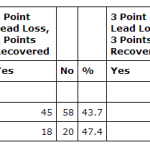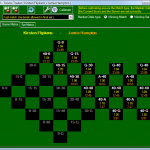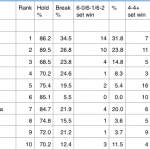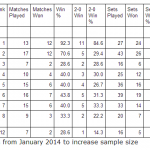Author Archive:

Assessing ATP players in late games of sets
Something that is frequently discussed on social media is a player’s ability at the start of the set, or at the end of the set. Last week we looked at the ability of servers in this respect, but today I want to take the opportunity to look at strong and weak returners at the beginning or close of sets.
As mentioned last week, it is possible using point by point data to look at start and end of set statistics, …

Using stats to generate entry points in Tennis
Something that is frequently discussed on social media is a player’s ability at the start of the set, or at the end of the set. This tends to be an imperfect subjective judgement which may or may not have sound statistical merit, but typically this doesn’t concern the average Twitter user!
It is possible using point by point data to look at start and end of set statistics, and to work out both whether there are different dynamics during these …

Tennis trading – Trading the Tiebreak
Many Thanks to Dan Weston who was the guest poster for this article, visit Dan’s excellent Tennis ratings site for lots of useful Tennis stats.
One area of trading which many Tennis traders seem unsure of, and some that I’ve spoken to even steer clear of completely, is tiebreak trading.
Tiebreaks are one of the most volatile parts of a Tennis match and due to this, it is possible for traders to have the ability to win and lose …

ATP In-Game Tennis Trading
Many Thanks to Dan Weston who was the guest poster for this article, visit Dan’s excellent Tennis ratings site for lots of useful Tennis stats.
Several weeks ago, we discussed point by point trading in the WTA, primarily looking at laying the player a break up and taking money out during a service game. As mentioned before, this allows more risk-averse traders to clear some or all liability at various in-game scorelines, and these were grouped into two brackets:-…

In-game Tennis Trading
One of the beauties of Tennis trading is that there are many possible approaches which can all be successful, with some traders preferring to be exposed to risk, with others keener to take a more risk averse approach.
When laying a server, or the player a break up, we have previously discussed trading out if and when the break occurs. However for the purpose of this article, I want to look at taking money out during a service game.
To …

Laying the Set One Winner
It doesn’t need much explaining that in a best of three set Tennis match, players need to win two sets to win, and once they have won the first set, they are 50% of the way towards the number of sets they need to claim to win the match.
Due to this, a player’s price will be significantly shorter than starting price when they win the first set, which is a lay entry point that many traders like.
Personally I …

Tennis – Dominant Sets in ATP Masters Events
A popular form of trading is laying the player a break up – I’ve written a great deal about it before, and the positive aspects of this type of trade is that it’s easily quantifiable (using projected hold and break lead/deficit loss/recovery statistics) and that risk is much more limited than taking a position when the set is on serve.
The worst result for this type of trade is when the player you have opposed turns a single break lead …

The best and worst players from winning positions in the ATP
Further to last week’s article which looked at the application of a blanket strategy, and the usage of WTA stats to illustrate why this is a bad idea, I thought I’d move onto some more detailed applications of statistics in the ATP, which is something I’ve been looking at in great detail lately.
An objective way to categorise front runners has been my major focus, with a particular plan of trying to work out which players are lucrative to …

Tennis Trading – Why a blanket strategy is usually unsuccessful
Frequently I get asked whether a given blanket Tennis trading strategy is a good idea, and almost always my answer is ‘it depends’. This probably frustrates the person posing the question, but it’s a genuine answer – it really does depend on the given situation, and the two players participating in the match.
The simple (and obvious) reason why this is the case is because not all players are created equally. Some players are good at serving, others’ strengths lie …

Court Speed in Tennis Trading
Recently on Twitter, there has been detailed conversation about court speed, and the impact that it has in Tennis.
As a trader, let me make one point abundantly clear here – I don’t care why the conditions at a venue is fast or slow, just that it will be, and that it is possible to ascertain this information in advance. Advance knowledge of conditions will enable me to work out the likelihood of players holding serve, and a fast hard …

Tennis trading – Assessing the first break of the match
Laying a player when a break up in the first set is a popular trading entry point, so I thought I’d go through some of the stats from the recent Miami Masters/Premier Mandatory tournament to get some concrete data for several variables for the player leading by the first break in the first set.
These variables were as follows:-
- ‘Train’ percentage – the percentage of the time that the player who took the first break in the set won the

Creating a Tennis Trading strategy
I’ve had a lot of people ask me about creating a Tennis trading strategy recently, so I thought I’d post an updated version of old article from January 2014 which a lot of people have found useful in the past.
For this article, my plan was to detail how to create and use an effective ‘script’ to trade a tennis match, by means of laying player’s service games and laying the player a break up in a set.
It is …

Assessing Over & Under Performing ATP Players
Having a strong interest in sports analytics, reading this article which focuses on the success of FC Midtjylland and Brentford FC – https://decorrespondent.nl/2607/How-data-not-humans-run-this-Danish-football-club/230219386155-d2948861- naturally piqued my interest. These two clubs – both owned by millionaire hedge fund manager and sports bettor Matthew Benham – use data analytics to assess performance in a number of areas, and one way that they use these analytics is to look for undervalued players in the transfer market.
When I read this article, my first …

Analysis of Top 10 ATP Players
As we saw last week in the analysis of the top women players, there was a big discrepancy between the several – Serena Williams (in particular), Sharapova and Halep – and the rest. I also discussed that previous research in the ATP showed that matches featuring two elite players had slightly more breaks than the average ATP match.
I decided to do detailed analysis of the current men’s top ten players to see if the tendencies of the WTA repeated …

Analysis of Top WTA Players
Top ten versus top ten is a facet of Tennis that is quite under-researched, and I’ve mentioned previously that generally the ATP elite players in particular have slightly more breaks of serve against each other than the Tour average.
Something I’ve also alluded to is the fact that some players are – to use a cricket phrase – a ‘flat-track bully’. According to dictionary.com, an exact definition is ‘a sportsperson who dominates inferior opposition, but who cannot beat top-level opponents.’ …






Connect
Connect with us on the following social media platforms.